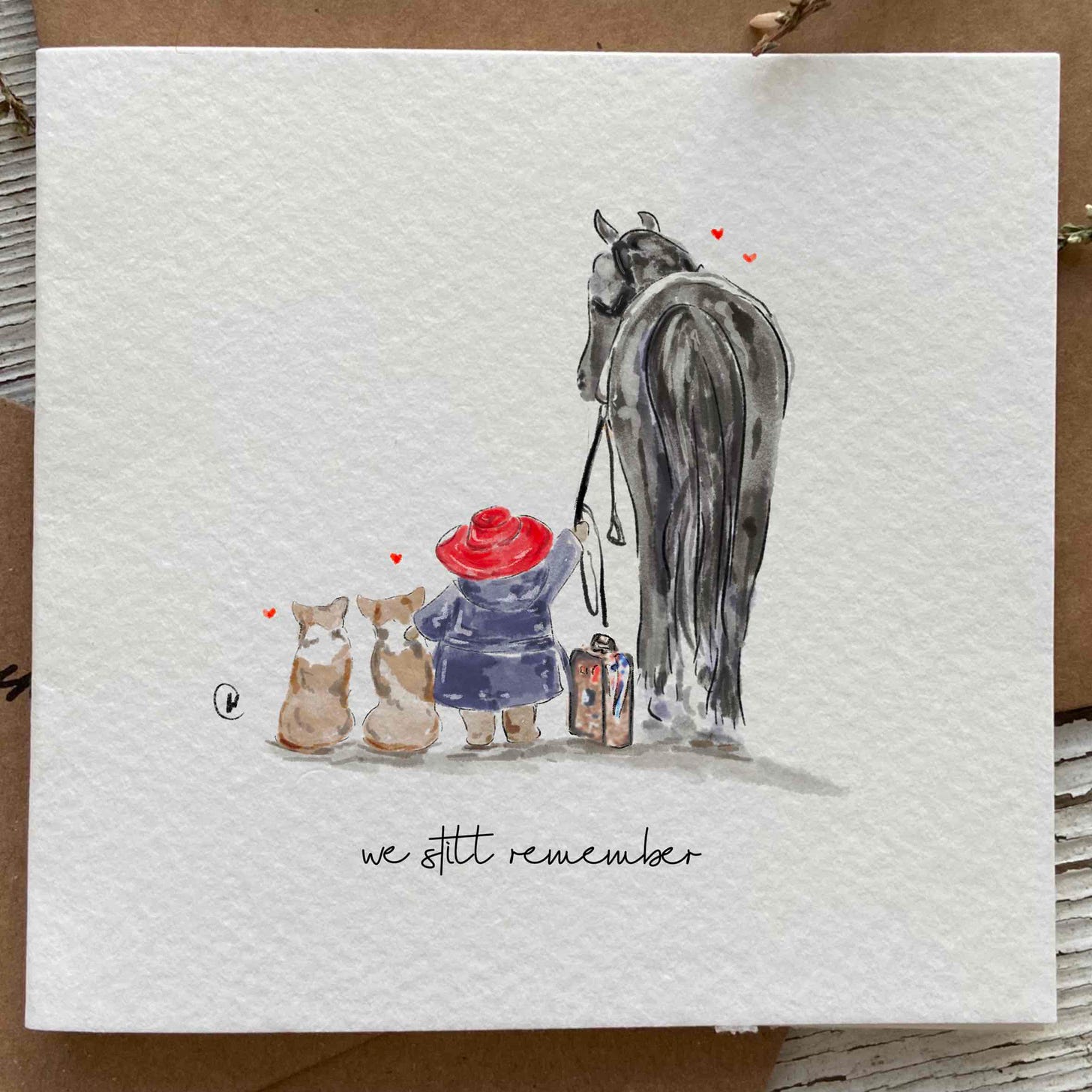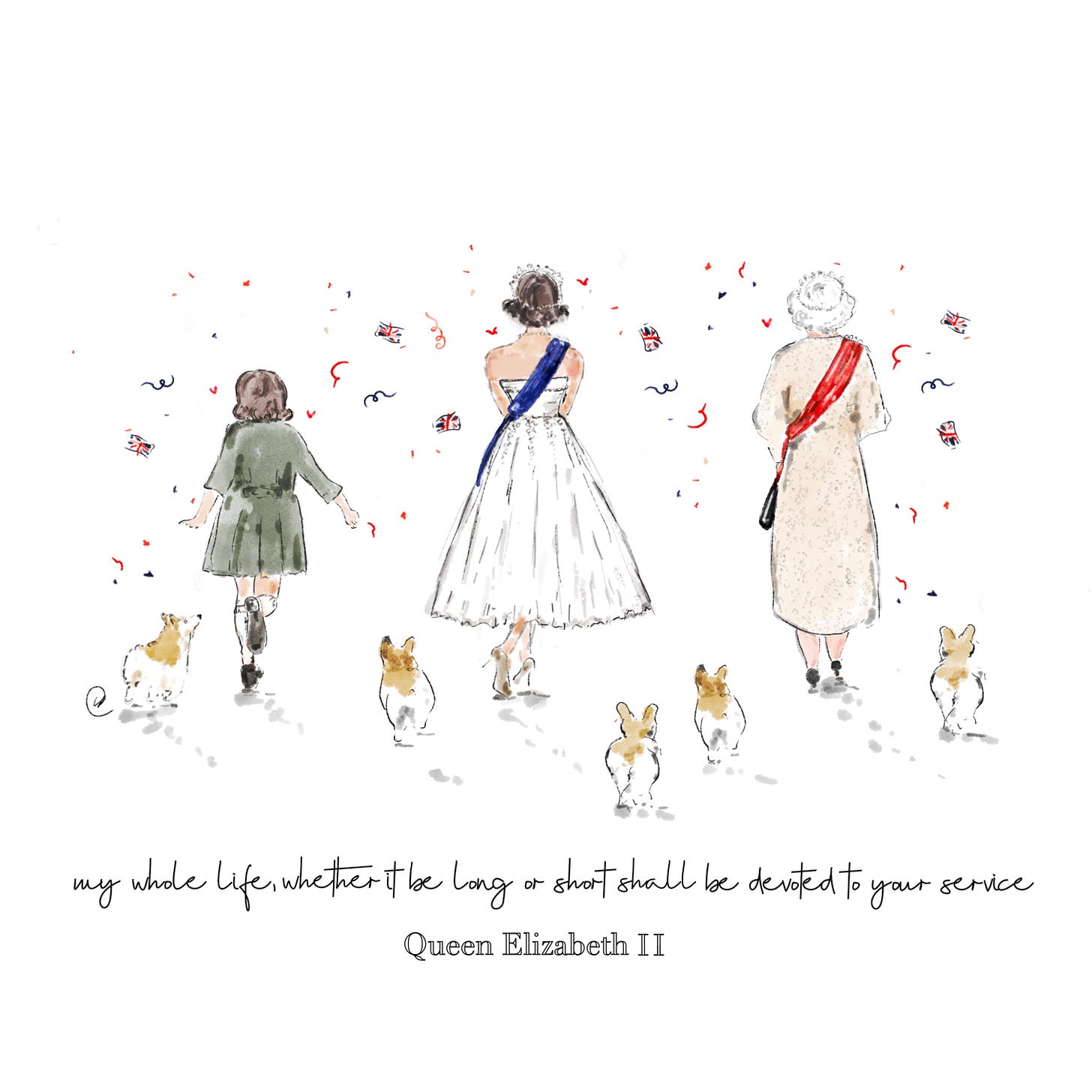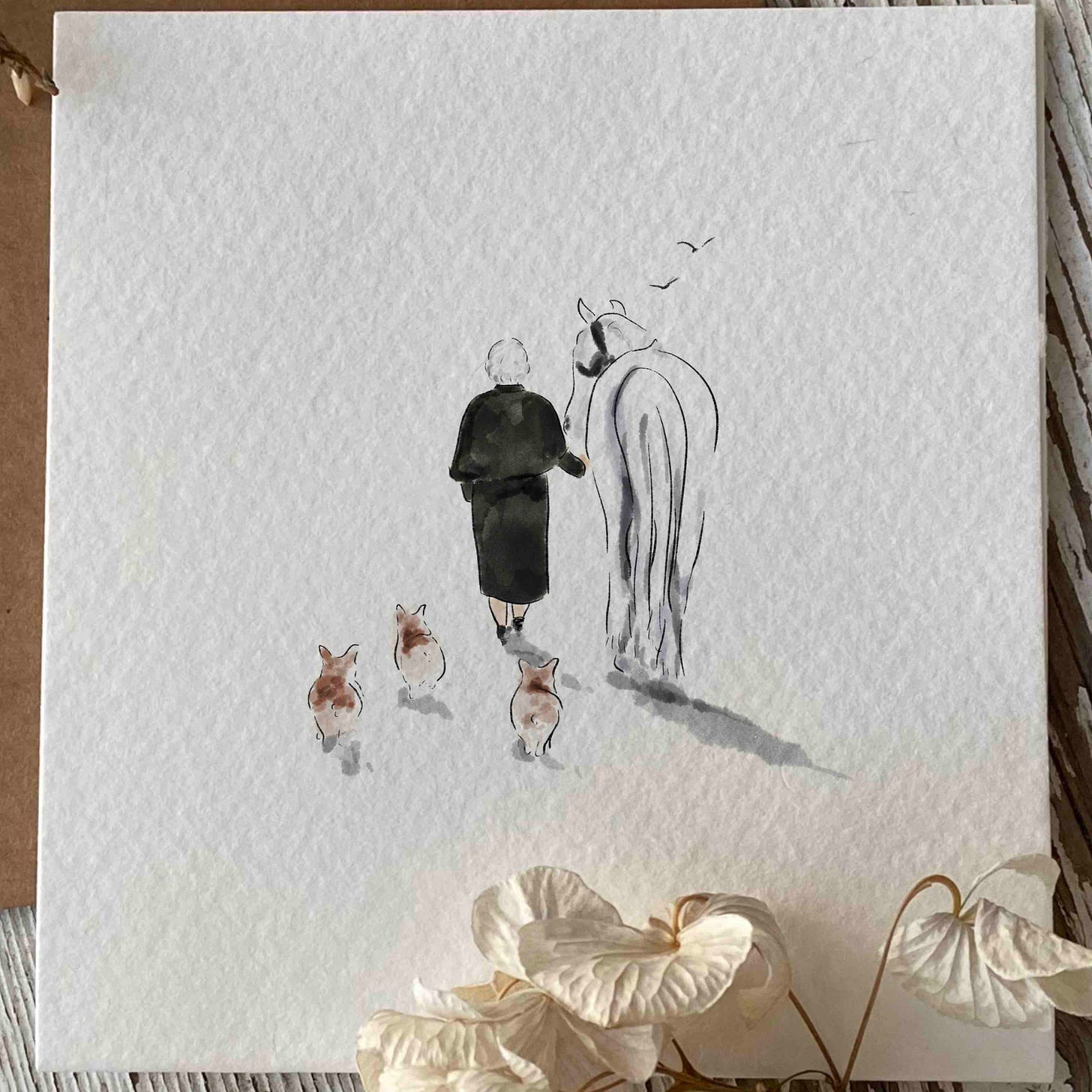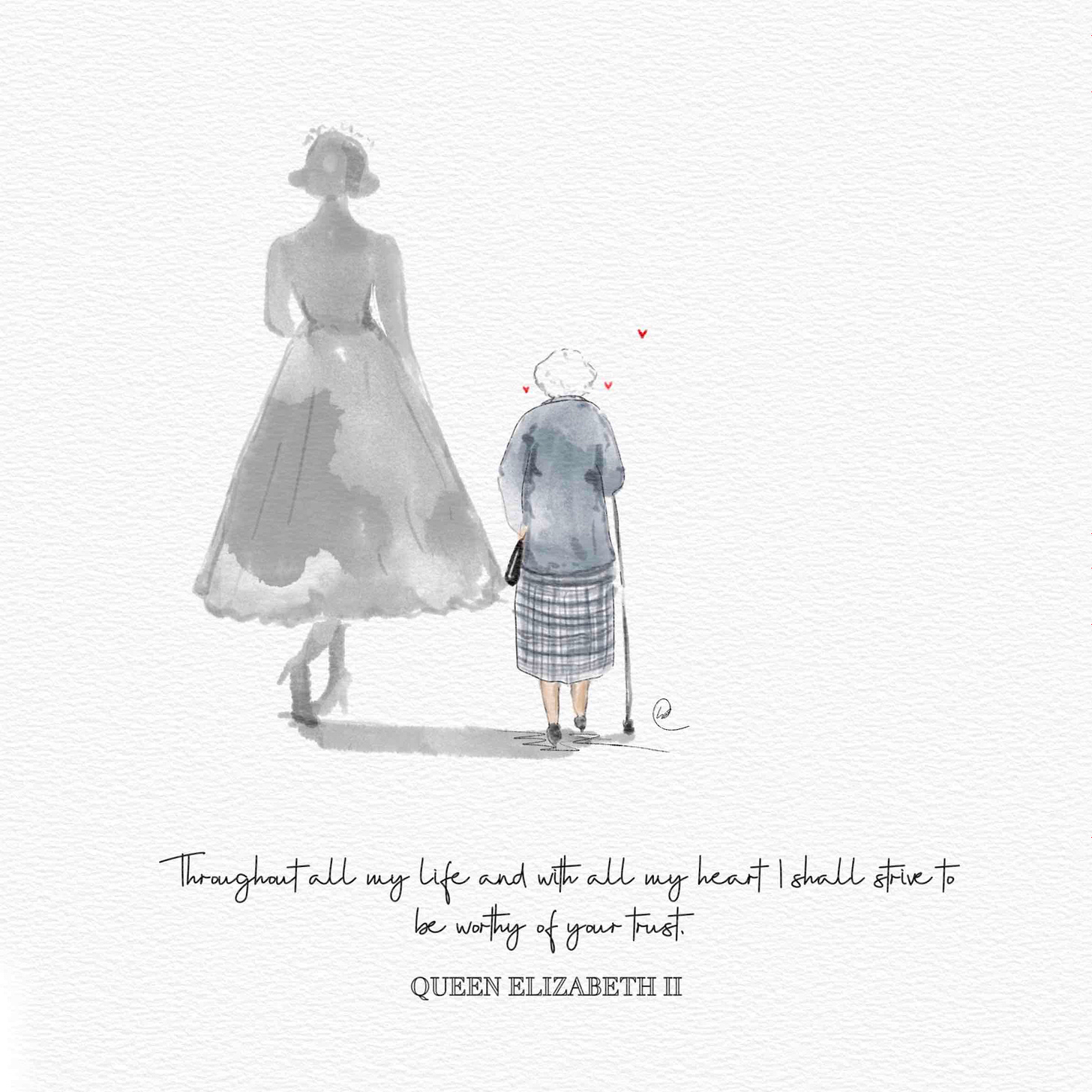The Art of Drawing the Royals
Lucy Claire Dunbar, the 26-year-old illustrator known for her unique point of view, shares her creative process.
Today felt like a fitting moment, given the one-year anniversary of the death of Queen Elizabeth II, to share the work of an illustrator known for her reflective portraits.
Lucy Claire Dunbar is one of several talented individuals I follow on Instagram who regularly draw the royals (other faves include Jennifer Vallez, Amelia Noyes, and Adrian Valencia). The 26-year-old Dunbar, who lives in Oxfordshire, has a particularly unique vantage point, often depicting her subjects from behind.
“It leaves the story open for people to fill in,” she told me when we chatted by Zoom. Her approach reminds me of the late queen, someone who was so widely known but who so few really knew. The way Elizabeth II lived her life meant everyone could project what they wanted or needed from her.
Dunbar draws the royal family and so much more, quickly capturing emotional moments in the zeitgeist. Her work first caught my eye around the time of the Platinum Jubilee last year, when a picture she drew of the queen with Paddington Bear went viral.
I reached out to Dunbar to chat with her about that image as well as her creative process. Below you will find our delightful conversation, discussing how she got back into drawing after someone told her to “give up,” what it felt like when the palace (!) reached out, and how she thinks about the late queen.
PS: Here is a link to her website and Etsy shop, where she sells beautiful cards and prints of her work.
🧵 I would love to hear how you are thinking about the royal family a year after the death of Queen Elizabeth II. Please share your thoughts in our discussion thread here.
💭 My latest royal fashion commentary, including two of Catherine’s Wimbledon outfits (that I did not post to Instagram!), are available in the SMT archive.
The discussion threads and SMT archive are open to paid subscribers. If you haven’t already, I hope you’ll consider upgrading your subscription for $5 a month. Thank you for your support!
The Art of Drawing the Royals with Lucy Claire Dunbar
Please note: Our conversation has been edited and condensed.
Let’s start at the start! How did you begin your career as an illustrator?
Lucy Claire Dunbar: My dad is actually a very well-known animator. He’s very good at his job, he’s the top dog. There are five of us kids and we are all artists. We’re all creative. We were literally brought up surrounded by art. It was part of us. I don’t know life without art. We would go to restaurants and my dad would be like, “Right, draw that waiter.” We were always drawing and always drawing in the moment. And that was how we all processed our emotions, through our art.
I’ve always been drawing, but I wouldn’t say I was the most talented soul. [Laughs] I was actually told in college, “You’ll never be an illustrator, give up, do something more computer focused.” So then I went to university and did graphic design.
During Covid, when everything shut down, I picked up my pencils and started drawing and sharing it on Instagram. It was never meant to be a business, it was never meant to go anywhere. It was really just a passion of mine. Now I feel I genuinely have won the lottery. I feel so lucky every day to be able to do this. Even talking to you, I’m pinching myself because I think this is it — it is the dream.
And I love people. My dad always calls art “the study of people.” I am fascinated by people and what people connect with, everyone’s story. That’s really where my art comes from, my surroundings and what’s going on in the world.
I admire how prolific you are! How would you describe your style?
I would say emotive and current. It’s very of-the-moment. Every post either has been drawn that day or the day before. I’ve got such a short attention span, so I have to draw quickly. We joke but I am addicted to drawing. I live and breathe it. I love it so much.
And it helps me process. I’m processing everything along with everyone else. That’s essentially what I’m doing when I’m sharing. I can look back on moments in time and it reminds me of what was going on in the world — a visual diary.
I have always been drawn to storytelling and how in one image you could tell a whole story. I also wanted to treasure people’s memories because that’s something I think is so precious.
You often add a few words to the bottom of your drawings. How does writing fit into your creative process?
I really enjoy adding the words. That’s almost my favorite part. I write what I’m feeling or what I feel the world is feeling at that moment. It sounds a bit cheesy, but it really comes from the heart.
And it can often be where the drawings start from. I’ll think of something in my head and be like, Hmm, like how am I gonna illustrate this and tell this narrative through the drawing? Which people are often quite surprised by, they think I draw and then come up with the words afterwards.
The point of view you have chosen for your drawings, from behind with often just a hint of profile, leaves a lot to the viewer in a really beautiful way.
I used to draw face-on people and then I started doing these back profile illustrations. I found those connected with people more because there wasn’t a definitive subject to it. People could see their grandma or their mom or themselves in it a lot more. It leaves the story open for people to fill in.
I’m not the best artist in the world, but I think it’s the message that reaches people. Sometimes I think I’m able to put into a drawing what someone’s feeling. They don’t even know how to process it or they’re not even sure what they’re feeling until they see it. And then they’re like, “Oh! Someone else is feeling that way, too.”
That approach really resonates with my memories of the queen. Let’s talk about Elizabeth II. She was the subject of your first royal illustration. What made you want to draw her?
The queen reminds me a lot of my grandma, which I think is pretty common in the UK. I thought she was incredible in her devotion to her job and to Britain and I admired how she kept going at such an age. My grandparents were very fond of her, so I think it was a connection to them.
My first drawing was of the queen and her horses for her birthday last year in April. In her birthday portrait, she’s got a dark coat on and her two horses beside her. I did my Lucy thing [laughs] and I flipped it, I had her walking away.
It was received really well, which was an honor. A lot of people connected with it, so I thought. Oh, maybe I’ll do a [Platinum] Jubilee collection. Seeing the queen reach such a milestone was amazing. I knew my grandma would have loved the jubilee, and she would’ve gotten so into it. She would’ve been waving her flag. It really took off from there.
And your jubilee collection included the illustration with Paddington that went viral, yes? Tell me what that was like.
It is so odd. I literally remember it to this day. I was watching the little snippet of the queen [with Paddington at the jubilee concert]. I just thought it was so funny and really showed her playful side, which I don’t think I even realized was there? I don’t think I’d ever realized that she was so up for anything — which again, really reminded me of my grandma. Up for anything, up for life really.
I started sketching that night while we were watching it. While we had some downtime in the morning, the next day, I finished it. I posted it and then we went out for our celebrations. When I came back to it, a half an hour later, it had gotten more likes than I’d ever received in my life. Something like 2,000 likes. I didn’t know what was going on. I didn’t really know what viral meant until that point.
Last I checked, it had more than 55,000 likes. What do you think it was about that drawing that resonated with so many people?
I really think it was seeing the queen’s human side. At that age, she was still devoting her life to her country — I still can’t believe, until her final days, she was doing that. I think everyone just realized, “Wow, she’s really done this for us.” And people were very grateful towards her.
What did that moment mean to you and your future as an illustrator?
I remember my family messaging me being like, “Lucy, what is going on? Why are people liking this?” And I’m like, “I don’t know! I don’t know what I’ve done!”
I had my Etsy shop and was selling the jubilee collection. I released the Paddington piece and got a thousand sales in 24 hours, which — wow! — was mind boggling. I didn’t even have the systems in place to take that on. My mum was helping, my sister was helping, we just sat in rows and packaged these pieces up together. It really just took off. Everyone wanted a piece from the day to remember.
Including the palace! Tell me about how they reached out.
I got a message from someone who works in the palace who wanted it for, at the time, Prince Charles and Camilla. It was wild, honestly. As you can tell now, I’m still speechless. I was like, I dunno if this is a scam. Is someone having me on?
I sent them a collection of the postcards that I created and a few full size prints, of all the designs I’d done for the jubilee and the celebrations. I honestly was like, What is happening? I’m sending cards to the palace!
The secretary said that they really liked them, but I didn’t hear back personally from them.
Did the experience make you want to draw the royals more often?
It didn’t necessarily make me do more royal things. There were just a couple of months where I carried on doing what I do, illustrating things that are happening in the world at the moment. And then in September, the queen passed away. It was a very uncertain time here. No one really knew, we’d never experienced anything like this. How do we process this? Where do we go from here? People wanted something to remember her by and remember such a momentous moment in history. There was a feeling that we were living through a moment in history that people will remember forever.
What was King Charles III’s coronation like for you?
There’s nothing better than feeling something and being able to draw it. I get quite vivid images in my head pretty quickly. I look back on that day with fond memories. I was just drawing throughout the day, recording this historic moment. I just felt blessed to be able to share it with everyone and help other people treasure it as well.
How are you feeling one year after the queen’s death?
The main thought that strikes me is that the world moves on. It will be the queen’s family who miss her everyday, who have the greatest hole left in their hearts. It’s a reminder not only that, at her core, the queen was human — a mum, a grandmother, a great-grandmother, which was translated into her connection with the world — but also that the love of family is what life is all about. Of course, the nation and the world still feels the loss. But we go on with our days.
(All images via Lucy Claire Dunbar)
My thanks to Lucy! You can find her on Instagram at @LucyClaireIllustration and shop her work at on her website and via her Etsy shop.
PS: Please share your thoughts on the royal family one year after the queen’s death in our SMT discussion thread here.
















As a huge fan of royal illustrators, this was such a pleasant surprise! ❤️ Love it!
What a great interview! I have seen her portraits and artwork before but never knew the backstory! This was so fascinating to read especially on the anniversary of the queen’s death.